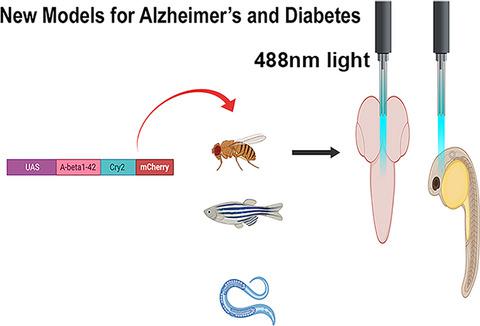Our official English website, www.x-mol.net, welcomes your
feedback! (Note: you will need to create a separate account there.)
Shared signaling pathways in Alzheimer’s and metabolic disease may point to new treatment approaches
The FEBS Journal ( IF 5.5 ) Pub Date : 2020-08-27 , DOI: 10.1111/febs.15540 Jahnavi Suresh 1 , Ing Wei Khor 2 , Prameet Kaur 1 , Hui Li Heng 3, 4 , Federico Torta 5 , Gavin S Dawe 3, 4 , E Shyong Tai 2, 6 , Nicholas S Tolwinski 1
The FEBS Journal ( IF 5.5 ) Pub Date : 2020-08-27 , DOI: 10.1111/febs.15540 Jahnavi Suresh 1 , Ing Wei Khor 2 , Prameet Kaur 1 , Hui Li Heng 3, 4 , Federico Torta 5 , Gavin S Dawe 3, 4 , E Shyong Tai 2, 6 , Nicholas S Tolwinski 1
Affiliation

|
‘A peculiar severe disease process of the cerebral cortex' are the exact words used by A. Alzheimer in 1906 to describe a patient’s increasingly severe condition of memory loss, changes in personality, and sleep disturbance. A century later, this ‘peculiar’ disease has become widely known as Alzheimer’s disease (AD), the world’s most common neurodegenerative disease, affecting more than 35 million people globally. At the same time, its pathology remains unclear and no successful treatment exists. Several theories for AD etiology have emerged throughout the past century. In this review, we focus on the metabolic mechanisms that are similar between AD and metabolic diseases, based on the results from genome-wide association studies. We discuss signaling pathways involved in both types of disease and look into new optogenetic methods to study the in vivo mechanisms of AD.
中文翻译:

阿尔茨海默病和代谢疾病的共享信号通路可能指向新的治疗方法
“大脑皮层的一种特殊的严重疾病过程”正是 A.阿尔茨海默氏症在 1906 年用来描述患者记忆丧失、性格改变和睡眠障碍等日益严重的情况的确切词。一个世纪后,这种“特殊”疾病被广泛称为阿尔茨海默病 (AD),这是世界上最常见的神经退行性疾病,影响全球超过 3500 万人。同时,其病理尚不清楚,尚无成功的治疗方法。在过去的一个世纪中出现了几种 AD 病因学理论。在这篇综述中,我们根据全基因组关联研究的结果,关注 AD 和代谢疾病之间相似的代谢机制。我们讨论了涉及这两种疾病的信号通路,并研究了新的光遗传学方法来研究AD的体内机制。
更新日期:2020-08-27
中文翻译:

阿尔茨海默病和代谢疾病的共享信号通路可能指向新的治疗方法
“大脑皮层的一种特殊的严重疾病过程”正是 A.阿尔茨海默氏症在 1906 年用来描述患者记忆丧失、性格改变和睡眠障碍等日益严重的情况的确切词。一个世纪后,这种“特殊”疾病被广泛称为阿尔茨海默病 (AD),这是世界上最常见的神经退行性疾病,影响全球超过 3500 万人。同时,其病理尚不清楚,尚无成功的治疗方法。在过去的一个世纪中出现了几种 AD 病因学理论。在这篇综述中,我们根据全基因组关联研究的结果,关注 AD 和代谢疾病之间相似的代谢机制。我们讨论了涉及这两种疾病的信号通路,并研究了新的光遗传学方法来研究AD的体内机制。











































 京公网安备 11010802027423号
京公网安备 11010802027423号